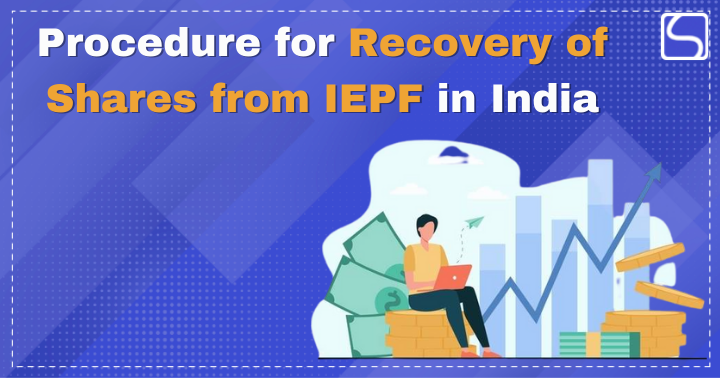Difference between Transmission of Shares and Transfer of Shares

Sherin Jose | Updated: Dec 02, 2022 | Category: Recovery of Shares
A transfer is an act of movement of an asset or the passing of ownership in certain assets either voluntarily and by the act of parties or by the operation of law. A share is a % of ownership in a financial asset or a company. Shares are transferable and can be used to generate working capital for a company. Shareholders are entitled to share the profits earned by a company but also must bear the losses incurred by it. In this blog, we will discuss difference between the Transmission of Shares and the Transfer of Shares.
Table of Contents
What is the Meaning of Transmission of Shares and Transfer of Shares?
- Transfer of shares is the act by which the transfer or voluntarily passes on the ownership in shares to the transferee for consideration. The transfer happens with the act of the parties involved and is facilitated by an instrument of transfer between the transferor & the transferee. Transfer of shares is governed by Section 56 of the Companies Act[1], 2013 &Rule 11 of Companies (Share Capital & Debentures) Rules, 2014. Transfer of shares can be facilitated by an instrument of transfer as provided in Rule 11(1) of Companies (Share Capital and Debentures) Rules, 2014, under Form SH-4. The such instrument needs to be duly stamped and executed along with the requisite details of the transferor and the transferee. Such instrument of transfer must be given to the company within 60 days of the execution of the instrument and with an allotment letter of securities and certificate of securities. If an application is made by the transferor for the transfer of shares which are only partly paid for, the company is to provide the transferee with a notice of the said application as provided under Form Sh-5 of Rule 11(3) of Companies (Share Capital and Debentures) Rules, 2014 and within two weeks of the receipt of notice stating a no objection to the transfer.
- Transmission of shares is the movement of shares which takes place due to the operation of law and in situations where the shareholder has become insolvent, a lunatic or has died or where the shareholder is a company that has wound up. The shares are transmitted to the legal representative of the deceased shareholder or the official assignee in case of insolvency. The transferee only needs to present with proof of entitlement to the shares and the same can be affected without any instrument of transfer. To affect transmission of shares, an application for transmission of shares must be filed along with requisite documents like a self-attested copy of PAN card, original share certificate, successor’s specimen signature, certified death certificate copy, a copy of a will or a succession certificate or probate or a court decree.
Transmission of Shares and Transfer of Shares – Differences
As understood from above, the transmission of shares and transfer of shares are vastly different modes of movement of shares from the shareholder based on many factors. The major differences between the transmission of shares and the transfer of shares are laid below:
- Nature
The act of transfer of shares is voluntary in nature. The transferor passes on the ownership in the shares to the transferee out of her own volition.
Transmission of Shares takes place only on the happening of certain events like death, insolvency, or lunacy of the shareholders. The ownership to the shares is passed on to the official assignee or the legal representative without the shareholder’s volition.
- Parties Involved
Shares are transferred between the transferor and the transferee and can be initiated by a voluntary act of either the transferor or the transferee.
Transmission of shares is initiated by the official assignee in cases of insolvency or the legal representative who provides proof as being entitled to the shares.
- Consideration
Transfer of shares is affected when the transferee pays adequate consideration to the transfer or for the ownership in shares.
Transmission of shares, no consideration is to be paid by the legal representative or the receiver of shares.
- Liability of the Transferor
The liability of the transferor ends after the shares are transferred as the liability associated with the shares is also transferred to the transferee.
The liability of the shareholder whose shares are transmitted persists even after the shares have been transmitted.
- Procedure
The transfer of shares is governed by Section 56 of the Companies Act, 2013 &Rule 11 Rules, 2014. Transfer of shares can be facilitated by an instrument of transfer as provided in Rule 11(1) Rules, 2014, under Form SH-4. The such instrument needs to be duly stamped and executed along with the requisite details of the transferor and the transferee. Such instrument of transfer must be given to the company within 60 days of the execution of the instrument and with an allotment letter of securities and certificate of securities. The directors of the company have to approve such a transfer. If an application is made by the transferor for the transfer of shares which are only partly paid for, the company is to provide the transferee with a notice of the said application as provided under Form Sh-5 of Rule 11(3) Rules, 2014 and within two weeks of the receipt of notice stating no objection to the transfer.
To affect the transmission of shares, the interested party needs to provide valid proof that she is entitled to such shares. Then an application for transmission of shares must be filed along with requisite documents like a self-attested copy of PAN card, original share certificate, successor’s specimen signature, certified death certificate copy, a copy of a will or a succession certificate or probate or a court decree. The company shall assess the application and documents submitted and create a transmission request. After reviewing the documents, if the company finds any error or shortcoming, the company shall inform the applicant of its refusal to transmit shares within 30 days. If the application is approved, the declared dividend until the shareholder’s death is paid to the applicant and a bonus, in cases where the shareholder has registered her name prior to her death.
- Instrument of Title
To effect a valid transfer of shares, a duly stamped and executed transfer deed with the requisite details of the transferor and the transferee is imperative.
Transmission of shares requires no such instrument for the passing of ownership to the requisite party.
- Stamp Duty
For the transfer of shares, stamp duty is payable on the market value of the shares. Meanwhile, there is no stamp duty payable for the transmission of shares.
- Lock-In Period
The Lock-in time period refers to the number of years during which an investor cannot sell or withdraw the funds created by her. For the transfer of shares, lock-in periods exist, while for the transmission of funds, they do not.
As laid out above, there are many differences between the transmission of shares and the transfer of shares. However, there exist certain common grounds between the two as well. Unless prohibited by any order of an adjudicating authority like a Court or a Tribunal or is expressly prohibited by law, the company must provide certificates of securities transmitted or transferred within 30 days from the date of intimation of transmission or date of receipt of the deed of transfer. Moreover, in case of non-compliance by the company of the above, the company shall b be liable to pay a fine which can range anywhere between Rupees Twenty-Five Thousand to Rupees Fifty Thousand. Every officer involved in the non-compliance shall be liable to pay a fine which can range anywhere between Rupees Ten Thousand to Rupees One Lakh.
Conclusion
Transmission of shares and Transfer of shares are ways in which the ownership in shares in a company or a financial asset passes to either the transferee or the legal representative or receiver of shares, as the case may be. The main differences between the two lie in the nature of the movement of ownership, the mode in which the ownership passes, and the parties, considerations, and liabilities involved.














